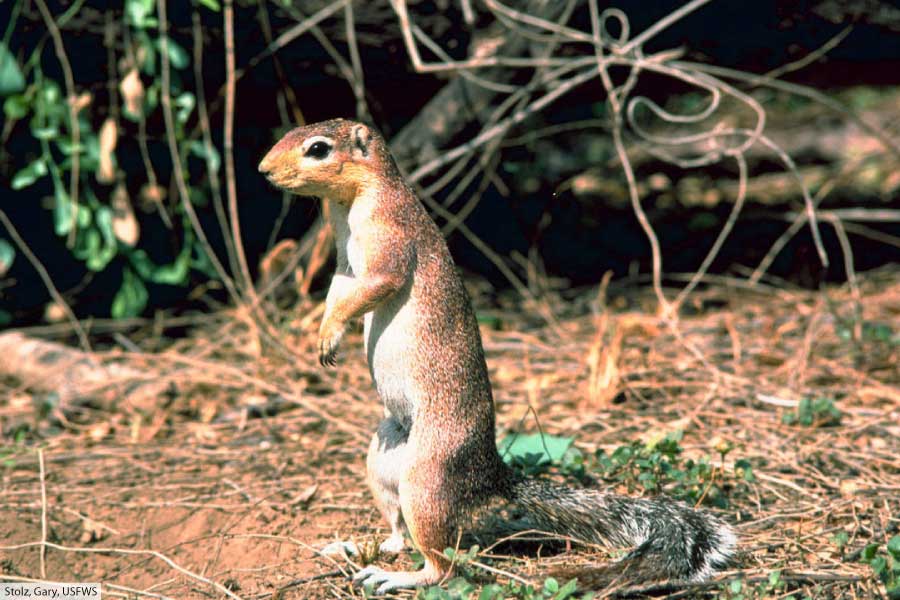African ground squirrel facts, pictures and information...
African Ground Squirrel Facts
African ground squirrels are rodents in the family Sciuridae, the squirrel family. As their name suggests, the African ground squirrels are terrestrial (ground-dwelling). Like their North American cousins the marmots and prairie dogs, African ground squirrels are burrowing animals.
Four of the five African ground squirrel species are in the genus Xerus: the striped ground squirrel; Cape ground squirrel / South African ground squirrel; mountain ground squirrel / Damara ground squirrel; and unstriped ground squirrel.
The fifth ground squirrel found in Africa is the Barbary ground squirrel.
- Confused by terms such as ‘genus’, ‘family’ and ‘class’? Check out our page on animal classification: Animal Classification
African ground squirrels typically live in arid (dry), rocky or grassland habitats. They live in colonies and are active during the day. They are omnivorous, with diets typically consisting of plant matter such as bulbs, fruit, grasses and herbs, together with insects, eggs, and small animals.
African ground squirrels may feed on crops, and are seen as pests in some regions. Predators of African ground squirrels include puff adders, monitor lizards, jackals and birds of prey.
African Ground Squirrel Species
Striped Ground Squirrel
- Scientific name: Xerus erythropus
- Conservation status: Least Concern
A relatively large species, the striped ground squirrel has a body length of between 22 and 29 cm (8.7 and 11.4 in.). Its tail is almost as long again. It is predominantly sandy-brown in color and has pale underparts. A distinctive pale stripe runs from the shoulder to the hip along either side of the body.
The striped ground squirrel has a large range, being found across Africa south of the Sahara Desert and north of the equatorial rainforests.
Cape Ground Squirrel / South African Ground Squirrel
- Scientific name: Xerus inauris
- Conservation status: Least Concern
The Cape ground squirrel is also known as the South African ground squirrel. It is found in dry grassland habitats in Botswana, South Africa and Namibia.
With a total body-tail length of around 42.4 to 47.6 cm (16.7 to 18.7 in), the Cape ground squirrel is smaller than the striped ground squirrel.
The Cape ground squirrel is red-brown in color, with paler undersides and face. A thin white line runs from the shoulder to the hip on each side of the body.
A colony of Cape ground squirrels responds to the presence of a snake with mobbing behavior. This involves the squirrels surrounding the predator and darting away if the snake should strike. This is often enough to drive the predator away.
Mountain Ground Squirrel / Damara Ground Squirrel
- Scientific name: Xerus princeps
- Conservation status: Least Concern
The mountain ground squirrel is closely related to the Cape ground squirrel. In fact, the two species are so similar that it can be different to tell them apart. The mountain ground squirrel is slightly larger on average, and its incisors are yellow-orange rather than white.
The species is found in savanna and shrubland in Namibia and Angola. It inhabits mountainous or hilly areas with sparse vegetation.
The mountain ground squirrel is less social than the Cape ground squirrel, with males often being solitary, and females living either alone or in small family groups.
Unstriped Ground Squirrel
- Scientific name: Xerus rutilus
- Conservation status: Least Concern
The unstriped ground squirrel is found several east African countries, including Ethiopia, Somalia and Kenya. Typical habitat for the species is dry savanna and shrubland.
As its name suggests, the unstriped ground squirrel is the only member of the genus Xerus not to have a line running along its flanks.
Barbary Ground Squirrel
- Scientific name: Atlantoxerus getulus
- Conservation status: Least Concern
The Barbary ground squirrel is found further north than other African ground squirrels, being present in Algeria, Morocco and Western Sahara (a small population of striped ground squirrels is also present in Morocco). The species has also been introduced to the Canary Islands.
The species is red-brown in color, with a distinctive white stripe running along each side. The undersides and face are white / gray.
The Barbary ground squirrel is active during the day, but will retreat into its burrow when the sun is at its hottest. It is found in dry grasslands and some mountainous regions.
Discover More with Active Wild
- Discover amazing animals from all around the world: A to Z Animals
- Discover more African animals: African Animals Pictures & Facts
- Now you know all about animals in the genus Xerus, find out about more Animals That Start With X
- Become a mammal expert: Mammals: The Ultimate Guide
- Become an animal expert: Animals: The Ultimate Guide







